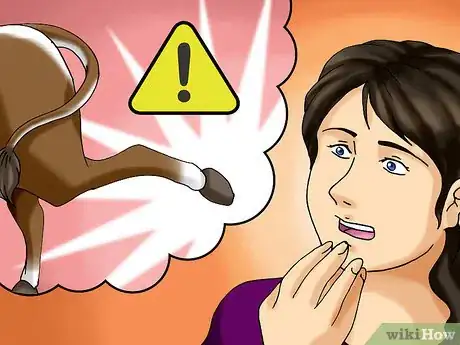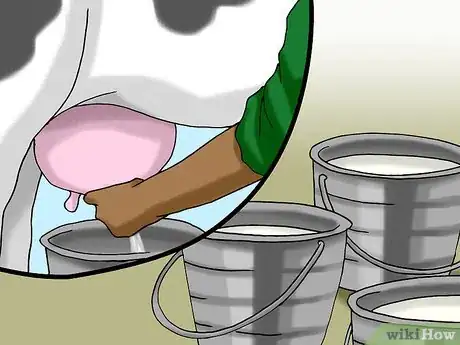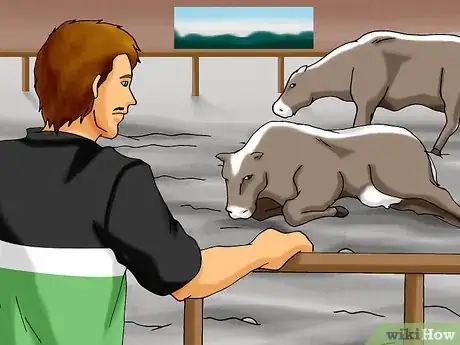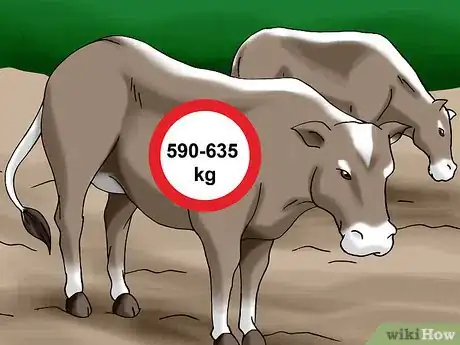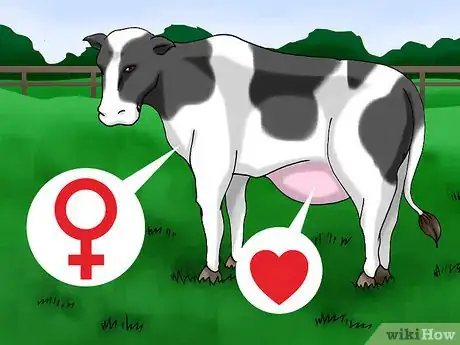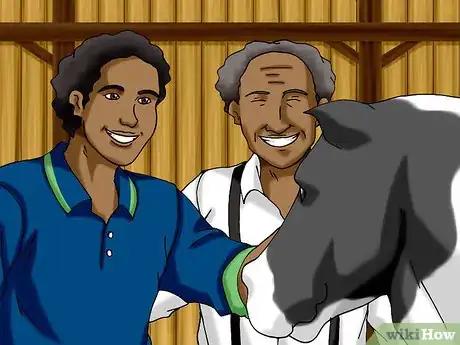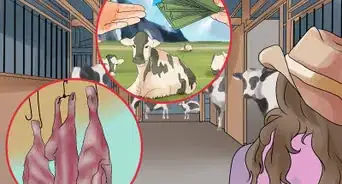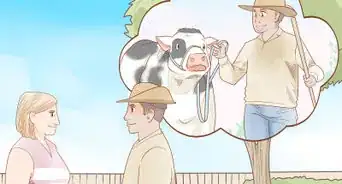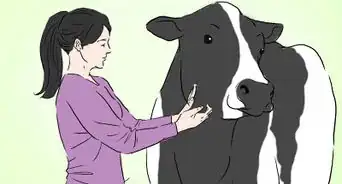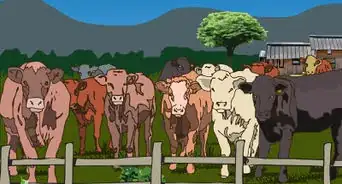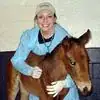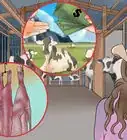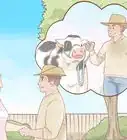This article was co-authored by Ryan Corrigan, LVT, VTS-EVN. Ryan Corrigan is a Licensed Veterinary Technician in California. She received her Bachelor of Science in Veterinary Technology from Purdue University in 2010. She is also a Member of the Academy of Equine Veterinary Nursing Technicians since 2011.
wikiHow marks an article as reader-approved once it receives enough positive feedback. In this case, 86% of readers who voted found the article helpful, earning it our reader-approved status.
This article has been viewed 202,062 times.
Whether you are seeking a family dairy cow (for your own use) or a cow to use on a dairy farm, there are several factors to consider. To choose the right breed, begin by determining your needs and limitations, such as your budget and how you will use the cow (and milk). Next, spend some time learning about common dairy breeds, such as Holsteins and Jerseys. Ultimately, with careful consideration, you will be able to select the best dairy cow for you.
Steps
Determining Your Needs
-
1Consider the cost of feed. The bigger the cow is, the more you have to feed her. Although, a bigger cow may produce more milk, you don’t want a monthly feed bill that exceeds what you’re able to spend.
- Holsteins are the biggest eaters and will cost the most.
- Brown Swiss cows are somewhere in the middle.
- Jerseys are the smallest and need the least amount to eat.
-
2Gauge the cow’s temperament. What kind of cow do you think you can handle? Can you deal with nervous cows or would you need to have very docile ones? Take this into consideration when selecting a breed.[1]
- Brown Swiss cows are the most docile dairy cows.
- Holsteins tend to be a bit nervous.
- Jerseys can be notorious kickers.
Advertisement -
3Decide what you’ll use this cow for. If you are raising a cow to be part of a dairy farm, obviously milk production will be a crucial factor. On the other hand, if you only need enough milk for your family, you may not need such a high-production breed. You may wish to mix your herd if it's for commercial reasons, such as adding a few Jerseys to a predominantly Holstein herd to increase the Holstein's butterfat content.
- If you're looking to maximize milk production, Holsteins are the way to go.
- If you're only wanting milk for you and your family, you may want to consider a cow that doesn't give as much milk (such as a Jersey).
- Breeds that are dual-purpose (produce both milk and meat) may be ideal, but this will produce less milk overall.
- You may also want a dairy cow for butter and cheese making. Jerseys and Brown Swiss produce milk higher in butterfat and protein content, making them ideal for cheese and butter making.
-
4Look at cull cows. Dairy cows that have been culled from conventional dairy operations are cheaper. However, such cows may have injuries, illnesses, or inability to breed back.[2]
- If you are a dairy farmer just starting out, avoid these cull animals.
- As a hobby farmer you may not mind the time, money and feed invested in rescuing and caring for one or two cull dairy cows.
Learning About Common Breeds
-
1Learn about Holsteins. Holstein cattle are classic black and white cows. They are by far the most popular dairy breed of all. Holsteins may be the most expensive animals (to purchase and to feed), but they are known for yielding the most milk.[3]
- Holsteins make up 90% of all dairy cows in the US.
- Although they are usually black and white, they can also be red and white.
- They are very large, typically around 1500 lbs. (680 kg) and 58 inches (1.47 meters) tall.
- They can thrive in a variety of settings.
- They typically produce at least 8-10 gallons (30.3-37.9 liters) of milk each day.
-
2Research Jerseys. Jersey cattle are the smallest dairy cow breed, and may be a little easier on the pocket book. They are beautiful cows known for their solid brown color, wide-set eyes, and long eyelashes.
- They typically weigh around 1100 lbs. (499 kg).
- Colors can range from light brown to almost black.
- Jerseys tend to give milk higher in butterfat, which makes them ideal if you want to make butter and cheese.
- They produce about 4-6 gallons (15.1-22.7 liters) of milk each day.
- They’re easy to breed because they’re fertile and easily give birth.
-
3Read about Brown Swiss cows. Brown Swiss cows are a popular breed, known for their sturdiness. They produce a decent quantity of milk, stay in lactation longer than other breeds, and tend to have a long lifespan.
- They are usually light brown or grey/silver.
- Brown Swiss cows usually weigh 1300 to 1400 lbs. (590-635 kg).
- This is said to be the best milk for cheese.
- They tend to have large calves and some cows may struggle with the first calf.
Choosing the Best Breed for You
-
1Consider what dairy breeds are available in your area. You may not be in an area where Holsteins, Jerseys, or Brown Swiss are prevalent. Determine which specific breeds are available in your area and research these.[4]
- Perform at internet search for common breeds in your region.
- Communicate with other dairy farmers in your area.
- Look in newspapers or online forums (like Craigslist) to see what cows are for sale near you.
- Contact a local auction house.
-
2Go with a breed that’s best for your intended use. Different breeds serve different purposes. If you are most interested in making cheese and butter, consider a Brown Swiss. If you want to keep the milk to drink at home, a Jersey cow may be best for you. Only opt for Holstein cows if you plan to sell the milk commercially and/or at local farmers markets.
-
3Choose a female that’s at the right stage of life. While you can purchase a heifer, a female who hasn’t yet birthed a calf, only cows, females who have given birth, can produce milk. You can choose a female in any stage of the reproductive process. The most expensive choice will be a young, high-producing cow. The cheapest will be a calf, but you have to feed it and raise it for a couple of years.[5] Your options include:
- A mature cow who has already calved.
- A pregnant cow who has had many cows before.
- A heifer who will get pregnant and have her first cow soon.
- A calf, that you’ll need to raise for about 2 years until it’s old enough to be bred.
-
4Purchase the cattle. When it comes time to purchase your cow, you essentially have two options: a private sale or an auction house. Whereas an auction house will sell only culled or slaughter animals, private sales will vary from seller to seller.
- Search for an auction house (or “auction mart”) in your area.
- Look in your local newspaper for sales.
- Search online platforms, like Craigslist.
- Speak to farmers in your area for leads.
- Talk to agricultural schools in your area. They may be able to sell you a cow they no longer need for studies or at least point you in the right direction.
- Contact your local 4-H chapter, which is a major youth organization. Since they work with dairy cattle, they may have information on who breeds, shows, and sells them in your area.
Expert Q&A
-
QuestionWhat characteristic should I look for in a dairy cow?
 Ryan Corrigan, LVT, VTS-EVNRyan Corrigan is a Licensed Veterinary Technician in California. She received her Bachelor of Science in Veterinary Technology from Purdue University in 2010. She is also a Member of the Academy of Equine Veterinary Nursing Technicians since 2011.
Ryan Corrigan, LVT, VTS-EVNRyan Corrigan is a Licensed Veterinary Technician in California. She received her Bachelor of Science in Veterinary Technology from Purdue University in 2010. She is also a Member of the Academy of Equine Veterinary Nursing Technicians since 2011.
Licensed Veterinary Technician You should consider what you want the cow for and how much space you have for it. Then, you should look for a cow that is comfortable around people, is healthy, and has a good body condition score. Also, look for a cow that interacts well within the herd, meaning it is alert, bright eyed, and doesn't stand alone away from the others.
You should consider what you want the cow for and how much space you have for it. Then, you should look for a cow that is comfortable around people, is healthy, and has a good body condition score. Also, look for a cow that interacts well within the herd, meaning it is alert, bright eyed, and doesn't stand alone away from the others. -
QuestionHow do I choose a healthy Jersey cow?
 Ryan Corrigan, LVT, VTS-EVNRyan Corrigan is a Licensed Veterinary Technician in California. She received her Bachelor of Science in Veterinary Technology from Purdue University in 2010. She is also a Member of the Academy of Equine Veterinary Nursing Technicians since 2011.
Ryan Corrigan, LVT, VTS-EVNRyan Corrigan is a Licensed Veterinary Technician in California. She received her Bachelor of Science in Veterinary Technology from Purdue University in 2010. She is also a Member of the Academy of Equine Veterinary Nursing Technicians since 2011.
Licensed Veterinary Technician To choose a healthy cow, look for one that has a good body weight; you should be able to feel the cow's ribs but not see them. Look for a cow with a shiny coat, clear eyes, and clear nose, that is alert and interested in interacting with its environment.
To choose a healthy cow, look for one that has a good body weight; you should be able to feel the cow's ribs but not see them. Look for a cow with a shiny coat, clear eyes, and clear nose, that is alert and interested in interacting with its environment.
References
- ↑ http://www.wellfedhomestead.com/choosing-a-dairy-cow-breeds
- ↑ http://www.beefmagazine.com/blog/5-tips-getting-most-cash-your-cull-cows
- ↑ http://www.holsteinusa.com/holstein_breed/holstein101.html?tab=2#TabbedPanels1
- ↑ http://www.livingthecountrylife.com/animals/livestock/16-common-cattle-breeds/
- ↑ http://countrysidenetwork.com/daily/livestock/cattle/selecting-the-best-dairy-cow-breeds/

